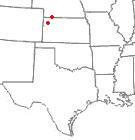|

Colby, Kansas | Mike,
When I'm comparing across different planting dates, if it is of a crop phenology/physiological nature i.e. growth stages, growth rates, etc., then I use cumulative GDD from planting, which lines up well with the data provided by most seed companies. If you have max and min air temp in excel here is an example formula to calculate. (Assumes temps are in F, headers in row 1, Max air temp in column A, Min air temp in column B, adjust accordingly for your sheet)
=(((IF(B2<50,50,B2))+IF(A2>86,86,IF(A2<50,50,A2))))/2)-50
So this calculation gets you GDDdaily, assuming this was done in C2, I always just go one column over for cumulative, run a sum while locking the first part of the sum, i.e. =sum($c$2:c2), then drag down as far as you need. So true GDD calculations for corn involve limits on both the max and min temp to be used, anything below 50 is set to 50 and anything above 86 is set to 86 (we use 100 for sorghum), that is what the IF statements handle., after the limits are set its just the average of the temps minus a base of 50. (Forgive me if I'm going through something you know well, just trying to be complete for other potential readers.)
Cumulative GDD may not be the right way to look at this soil temp data, but something to keep in mind, or try if you want.
If what I am working on is soil water related from two different planting dates, I will put it on cumulative reference ET, either grass or alfalfa reference will work. This data should be available at http://climate.sdstate.edu/climate_site/ag_data.htm (you probably already know this site)
Here is an example run from Hamill (I just picked it because I drove through there once LOL), for some reason the Redfield station has no data since April 2012? I'd call and complain if I were you ;-)
http://climate.sdstate.edu/awdn/et/et.asp?from=5%2F1%2F2012&to=10%2...
The reflectance of a surface crust could certainly be it also. Surface reflectance, technical term is albedo if I recall correctly, plays a huge role in energy balance, especially as you move towards the surface (obviously lol). Not sure when the curst formed, but there would also be the potential for a compounding effect, if the soil dried as the crust formed and was lower moisture content than the other field you have two things then producing the response, lower soil moisture and less buffering, and due to increased albedo less energy entering the system to drive temperature changes.
On the graphs you put up today of the 2" and 8" in row-middles, what stands out to me is that the difference between Field 1 and Field 2 is a function of temperature, ie. as the temp of Field A increases, the difference between A and B goes up, not much difference when the temps are in the 50's but as temp goes up they start to spread. To me that indicates it is energy balance related, ie. reflectance due to crusting, or differences in surface residue level that keep a layer of cool air above the soil surface, and quite possibly a more humid cool layer which would even further slow changes in soil temperature. Do you think there was any differences in surface residue level between inter-rows in the two fields?
Just for kicks and giggles you may plot (B-A) on the y axis and A on the x axis.
All sorts of diurnal things really can effect near-surface measurements. I had a study a couple of years ago where I was collecting soil moisture, 2 depths, at 1 minute intervals in 12 plots. The diurnal trends were interesting, but difficult to mess with when trying to get trends over time, I was trying to look at the decline over time to estimate surface evaporation. We ended up writing some code to pull out the max and min of each day and then ran a regression line through those, Figures 1 and 2 in the attachment.
As a side note, back in 2004 I was working on a project looking at machine efficiency of stripper headers, I worked with some guys with Spink County Implement in Redfield if I recall to get some customers data... Can't remember the guys name, in a file cabinet around there somewhere. Would like to visit that area sometime, SD is a bit of an intriguing place to me, went up to Reliance last year, had never been in central SD before, that trip left me with more questions than answers LOL. My only time east river has been in Brookings.
Lucas
Edited by LHaag 3/23/2013 13:03
Attachments
----------------
 Stubble Poster 062 Revised.pdf (256KB - 118 downloads) Stubble Poster 062 Revised.pdf (256KB - 118 downloads)
| |
|


 this has me puzzled (soil temps from 2012)
this has me puzzled (soil temps from 2012)